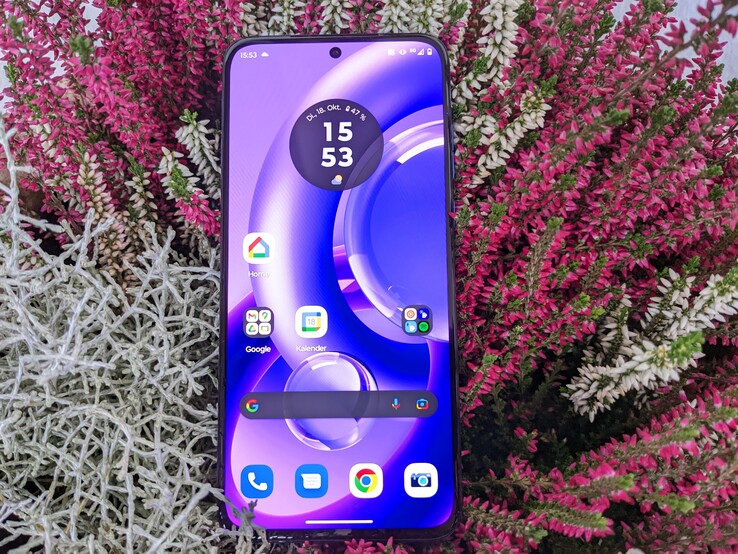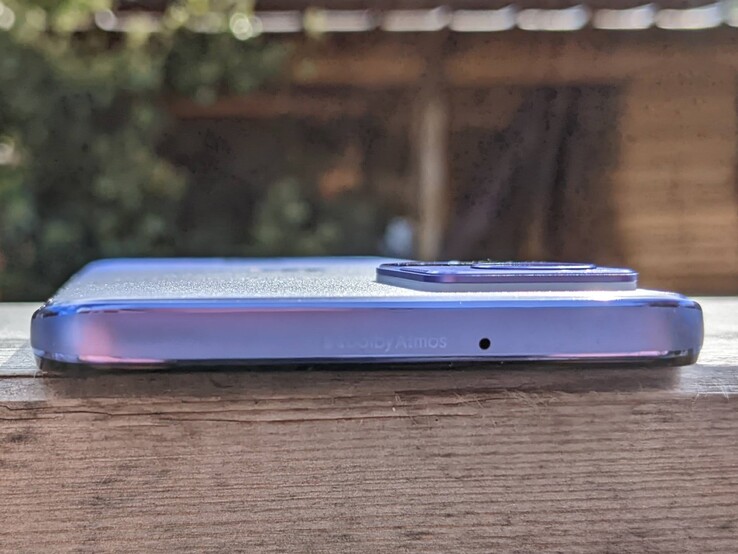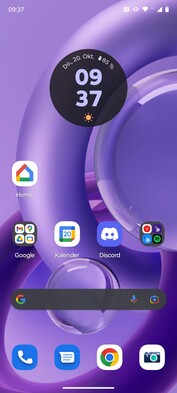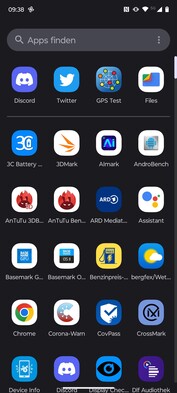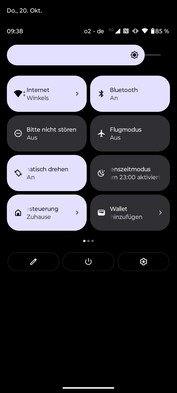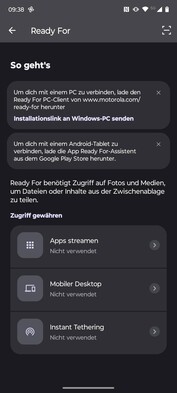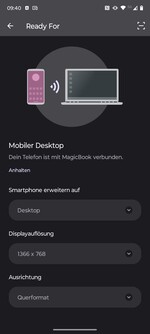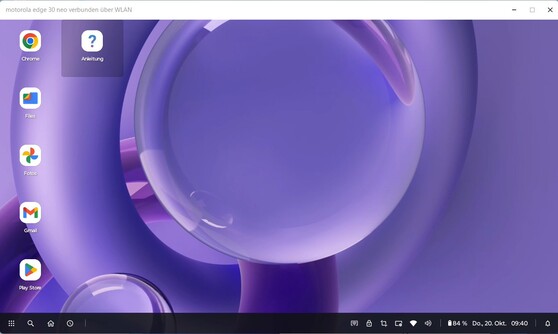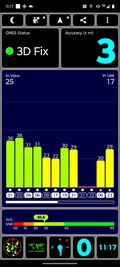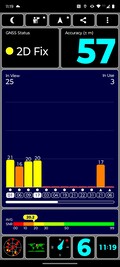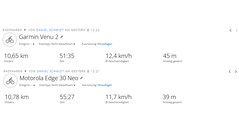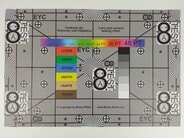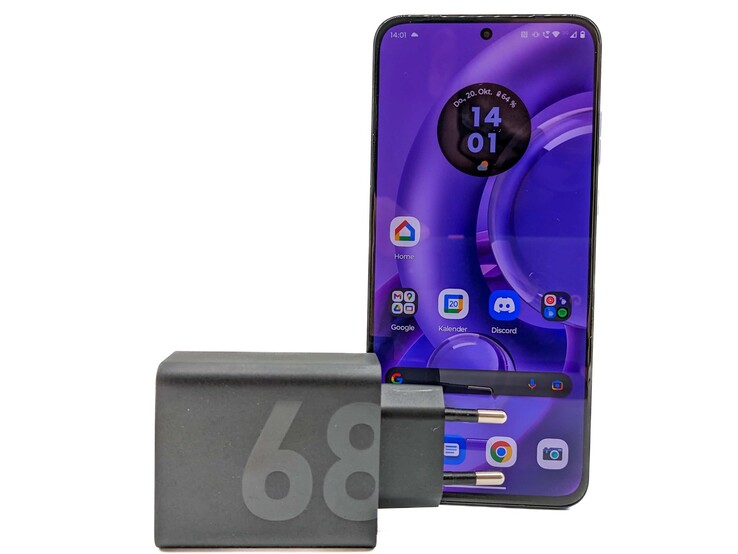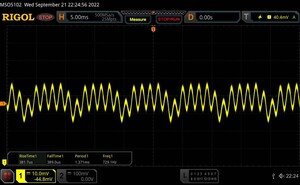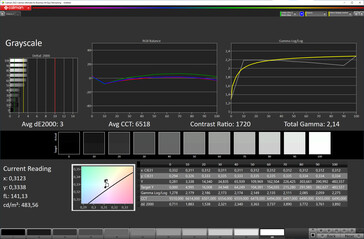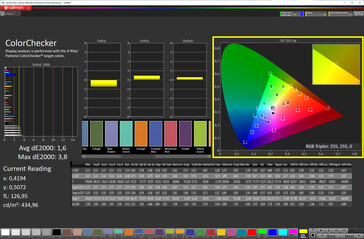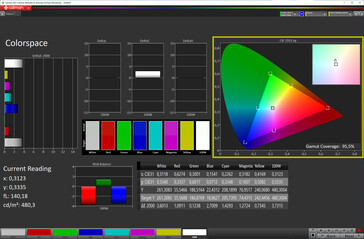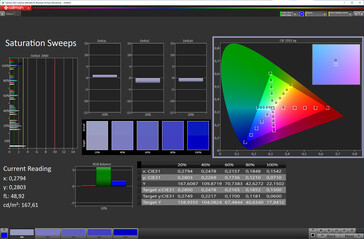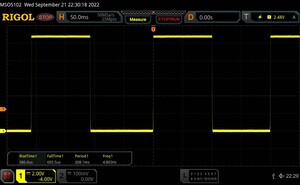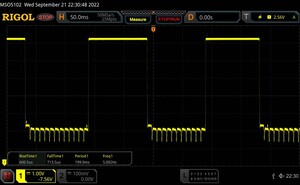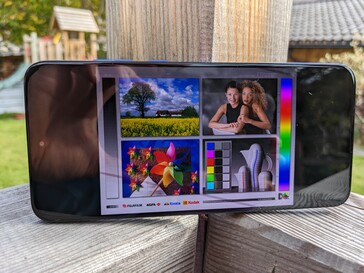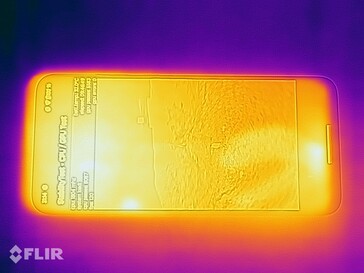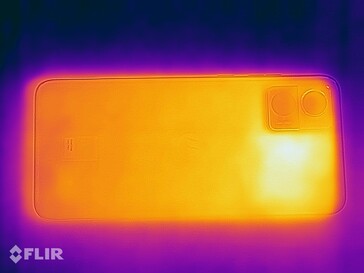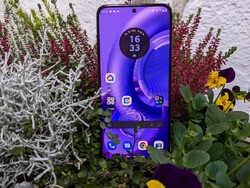Motorola Edge 30 Neo smartphone review - Compact beauty
Motorola renews the Edge 30 lineup. Besides the new models, Fusion and Ultra, the Edge 30 Neo is a cheaper entry-level device that is positioned below the Edge 30 without a name extension.
The Neo only comes in a configuration with 8 GB of RAM and 128 GB of storage. An expansion of the storage via microSD card is not possible. In return, there are four colors to choose from. Besides black and white, Motorola also offers "Aqua Foam", a lime green, and "Very Peri", the purple color of our review sample. Except for the white, all colors were developed in cooperation with Pantone. The respective color is displayed as a small square on the back.
Possible competitors in comparison
Rating | Date | Model | Weight | Drive | Size | Resolution | Price |
|---|---|---|---|---|---|---|---|
| 83.6 % v7 (old) | 10 / 2022 | Motorola Edge 30 Neo SD 695 5G, Adreno 619 | 155 g | 128 GB UFS 2.2 Flash | 6.30" | 2400x1080 | |
| 81.9 % v7 (old) | 08 / 2022 | Xiaomi Redmi Note 11 Pro 5G SD 695 5G, Adreno 619 | 202 g | 128 GB UFS 2.2 Flash | 6.67" | 2400x1080 | |
| 85.8 % v7 (old) | 09 / 2022 | Google Pixel 6a Tensor, Mali-G78 MP20 | 178 g | 128 GB UFS 3.1 Flash | 6.10" | 2400x1080 | |
| 83.4 % v7 (old) | 06 / 2022 | Samsung Galaxy A53 Exynos 1280, Mali-G68 MP4 | 189 g | 128 GB UFS 2.1 Flash | 6.50" | 2400x1080 |
Case - Compact Edge with straight display
Motorola's Edge 30 has a 6.3-inch straight display and is thus quite compact. The display's edges are a bit wider than those of the Edge 30 Fusion with a curved display, but they are nice and even. The Edge 30 Neo is pleasantly light at 155 grams (~5.5 oz).
The camera hump on the back clearly protrudes, which makes the device wobble when it is placed on a flat surface. This is hardly annoying when typing, but touching the upper area leads to strong wobbling.
The build quality is very good, the gaps are small and even. The keys have a slight play in the case. The device has an IP52 certification.
Equipment - Edge 30 Neo only in one variant
The Motorola Edge 30 Neo comes with 8 GB of RAM and 128 GB of storage. It is dual-SIM capable with two physical nano-SIM cards. Motorola also installs stereo speakers that are Dolby Atmos certified.
The power button and volume keys are both on the right side and they are placed very high. The tester can reach power and volume down with the thumb, but the hand has to be stretched out to reach the volume up button.
Software - Stock-Android Feeling
The Edge 30 Neo ships with Android 12. Motorola's My UX is almost stock Android with some extensions like the well-known Moto gestures. Shaking the device makes the flashlight shine, for example. Motorola promises two years of OS and three years of security updates from the device's sales launch. At the time of testing, the September security patch was installed.
The Edge 30 Neo also supports Motorola Ready For. With this software, the smartphone can be connected to a screen, TV or PC and used as a desktop. Apps can be displayed on the large screen, and files can also be moved between the devices. The connection is established via USB cable or wirelessly via WLAN
Communication and GNSS - Wi-Fi 6 is missing on the Neo
Motorola's Edge 30 Neo supports 5G, but unfortunately not Wi-Fi 6. The Edge 30 Neo is on par with the comparison devices in the measurements with our test router, the Asus ROG GT-AXE1000. The connection is established quickly and remains stable.
5G reception is supported on both SIM cards. The reception is acceptable in the test. The Neo has good frequency coverage in the different wireless standards, and operation in European cities should not be a problem.
The Edge 30 Neo cannot convince with the GNSS connection. A connection is established quickly outdoors, but it does not support dual-band GNSS. Indoors, the connection takes a long time even near a window and the positioning is inaccurate. The smartphone is also weak when recording routes.
On a bike ride with our comparison device, the Garmin Venu 2, the Edge 30 Neo shows weaknesses. The recorded route deviates from the road in many areas. Curves and radii are displayed angularly.
Phone features and voice quality - Edge 30 Neo is clear and crisp
Motorola relies on Google software for the phone app. The program is convincing in practice and is clearly structured. The smartphone supports calls via WLAN and features Motorola's "ChrystalTalk AI", a software that is supposed to reduce background noise during calls.
The result is pleasing in practice. The voice quality is good for both participants, there is no hiss or other annoying noises. Voices are transmitted clearly and naturally.
Cameras - Only two lenses on the Neo
Motorola does without a third lens on the back of the Edge 30 Neo. The 64 MPix main camera is only flanked by a 13 MPix ultra-wide-angle camera that is also responsible for macro shots. The quality of the installed cameras is convincing. The pictures are sharp, the color balance is good and similar for both lenses.
The camera software offers a Pro mode for photos. The focus can be adjusted manually, as well as the white balance, the exposure time and the ISO value. There is also a Full Resolution mode to take pictures with 64 MPix and avoid pixel binning.
The pictures of the 32 MPix front-facing camera convince with sharpness and good dynamic range. The portrait mode also works reliably
The camera app is clearly arranged, but offers few setting options. This is particularly noticeable in video recordings. There is no option to change the resolution of the recordings, there is only a choice between 30 and 60 FPS. Thus, the setting options are exactly the opposite of the Motorola Edge 30 Fusion. The stabilization of the video recordings is good, but the autofocus is very erratic.
Image comparison
Choose a scene and navigate within the first image. One click changes the position on touchscreens. One click on the zoomed-in image opens the original in a new window. The first image shows the scaled photograph of the test device.
Main camera RabbitMain camera LakeUltra wide-angle5x ZoomLow-LightMotorola had a good hand in the camera's color matching. The deviations in ColorChecker are very low, at least in good lighting conditions.
The Edge 30 Neo's camera reaches its limits in only one lux of light. The color deviation becomes large, or the camera captures very little light. Details on the test chart are also hardly recognizable.
In contrast, in bright light, the sharpness of the pictures is convincing and only decreases towards the edges.
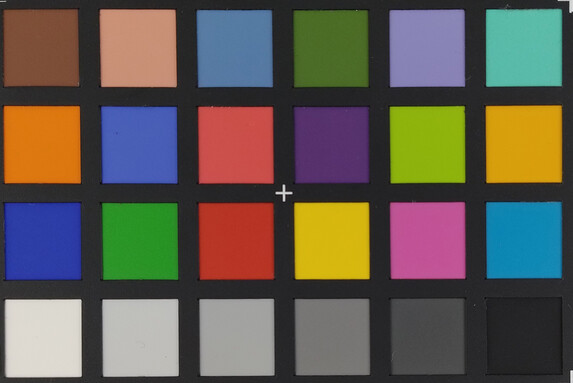

Accessories and warranty - Motorola supplies 68-watt charger
It is pleasing that Motorola does not save on the power supply even for the cheapest version of the Edge 30 series. The Neo comes with a 68-watt charger and a matching USB-C cable. There is also a transparent plastic case.
Motorola grants a warranty of 24 months for the smartphone in Germany. The warranty period can be extended by one year and accident protection is available via the Moto Care program.
Input devices & operation - Neo with in-display fingerprint scanner
Motorola uses Google's GBoard keyboard ex-works. In practice, there are hardly any typos in portrait as well as landscape mode.
The touchscreen's gliding properties are very good, and the operating speed and accuracy are convincing in the test. Unlike the Edge 30 Fusion there is no protective film on the screen.
The device is unlocked via an optical fingerprint reader in the display. The positioning is far down. However, the optical scanner convinces in terms of speed and reliability. Alternatively, unlocking is possible via the front camera. The 2D face recognition is less secure, but also works quickly and reliably.
Display - Edge 30 Neo with 120 Hz display
The Edge 30 Neo has a 6.3-inch OLED panel in 20:9 format. Unlike the Edge 30 siblings, Motorola relies on a straight display in the Neo. The refresh rate is somewhat reduced, but still peaks at a fast 120 Hz. The user has the choice between fixed levels at 60 and 120 Hz or leaving the choice to the AI depending on the content being displayed. With flexible display, the display can also show content at 48 and 90 Hz.
The maximum brightness with the ambient light sensor enabled is 1,190 cd/m²; the Neo still manages 491 nits in the test with the sensor disabled.
We detected PWM during the measurement up to a display brightness of 68 percent. Above that, the frequency is 120 Hz and thus the panel's refresh rate. 120 Hz is also the value in DC dimming mode. We could not determine temporal dithering on the smartphone. For this, the display is filmed through a microscope at 240 fps with an iPhone.
Unfortunately, Motorola does not offer an Always-On display in the Edge 30 Neo.
| |||||||||||||||||||||||||
Brightness Distribution: 98 %
Center on Battery: 984 cd/m²
Contrast: ∞:1 (Black: 0 cd/m²)
ΔE ColorChecker Calman: 1.6 | ∀{0.5-29.43 Ø4.78}
ΔE Greyscale Calman: 3 | ∀{0.09-98 Ø5}
95.5% sRGB (Calman 2D)
Gamma: 2.14
CCT: 6518 K
| Motorola Edge 30 Neo pOLED, 2400x1080, 6.3" | Xiaomi Redmi Note 11 Pro 5G AMOLED, 2400x1080, 6.7" | Google Pixel 6a AMOLED, 2400x1080, 6.1" | Samsung Galaxy A53 AMOLED, 2400x1080, 6.5" | |
|---|---|---|---|---|
| Screen | -1% | 12% | -6% | |
| Brightness middle (cd/m²) | 984 | 675 -31% | 758 -23% | 718 -27% |
| Brightness (cd/m²) | 992 | 686 -31% | 767 -23% | 730 -26% |
| Brightness Distribution (%) | 98 | 95 -3% | 93 -5% | 92 -6% |
| Black Level * (cd/m²) | ||||
| Colorchecker dE 2000 * | 1.6 | 1.3 19% | 0.9 44% | 1.62 -1% |
| Colorchecker dE 2000 max. * | 3.8 | 3.9 -3% | 2.5 34% | 4.21 -11% |
| Greyscale dE 2000 * | 3 | 1.7 43% | 1.6 47% | 2 33% |
| Gamma | 2.14 103% | 2.16 102% | 2.2 100% | 2.156 102% |
| CCT | 6518 100% | 6591 99% | 6599 98% | 6545 99% |
* ... smaller is better
Screen Flickering / PWM (Pulse-Width Modulation)
| Screen flickering / PWM detected | 730 Hz | ||
The display backlight flickers at 730 Hz (worst case, e.g., utilizing PWM) . The frequency of 730 Hz is quite high, so most users sensitive to PWM should not notice any flickering. In comparison: 53 % of all tested devices do not use PWM to dim the display. If PWM was detected, an average of 8111 (minimum: 5 - maximum: 343500) Hz was measured. | |||
Measurement series with fixed zoom level and different brightness settings
The contrast of Motorola's panel is perfect, which is typical for OLEDs. The color matching of the display is also successful. The deviation is only slightly larger in the grayscale, but not annoying.
Display Response Times
| ↔ Response Time Black to White | ||
|---|---|---|
| 1.19 ms ... rise ↗ and fall ↘ combined | ↗ 0.586 ms rise | |
| ↘ 0.6055 ms fall | ||
| The screen shows very fast response rates in our tests and should be very well suited for fast-paced gaming. In comparison, all tested devices range from 0.1 (minimum) to 240 (maximum) ms. » 5 % of all devices are better. This means that the measured response time is better than the average of all tested devices (20.2 ms). | ||
| ↔ Response Time 50% Grey to 80% Grey | ||
| 1.31 ms ... rise ↗ and fall ↘ combined | ↗ 0.6005 ms rise | |
| ↘ 0.7135 ms fall | ||
| The screen shows very fast response rates in our tests and should be very well suited for fast-paced gaming. In comparison, all tested devices range from 0.165 (minimum) to 636 (maximum) ms. » 5 % of all devices are better. This means that the measured response time is better than the average of all tested devices (31.6 ms). | ||
The panel of the Motorola Edge 30 Neo is very bright. It leaves all comparison devices far behind and is always very easy to read even in full sunshine.
The readability of the display from different viewing angles is very good. There are no distortions or color changes.
Performance - Edge 30 Neo smooth in everyday use
Motorola relies on the Snapdragon 695 5G in combination with an Adreno 619 Graphics unit for the Edge 30 Neo. This is anything but a high-end processor, but the performance in everyday use is completely sufficient. Apps open quickly and even many open tabs in the browser do not make the Neo sweat.
The benchmark results show that the Neo's performance is within the class average. The comparison devices are very close to each other. Only the Tensor chip in the Pixel 6a can clearly outperform in some tests.
| UL Procyon AI Inference for Android - Overall Score NNAPI | |
| Google Pixel 6a | |
| Average of class Smartphone (3769 - 81594, n=139, last 2 years) | |
| Xiaomi Redmi Note 11 Pro 5G | |
| Motorola Edge 30 Neo | |
| Honor Magic4 Lite | |
| Average Qualcomm Snapdragon 695 5G (5442 - 9348, n=15) | |
| Samsung Galaxy A53 | |
| AImark - Score v2.x | |
| Google Pixel 6a | |
| Average Qualcomm Snapdragon 695 5G (4924 - 5839, n=10) | |
| Xiaomi Redmi Note 11 Pro 5G | |
| Honor Magic4 Lite | |
| Samsung Galaxy A53 | |
The results of the GPU benchmarks are similar to those of the CPU evaluation. The Edge 30 Neo behaves decently and is within the class average.
Current games like PUBG Mobile cannot be played in the highest settings. However, the display is smooth with HD settings and a high frame rate.
The performance of the UFS 2.2 storage on the other hand is a bit below average. Except for the Honor Magic4 Lite all comparison devices have faster memory on board.
GFXBench (DX / GLBenchmark) 2.7: T-Rex Onscreen | 1920x1080 T-Rex Offscreen
GFXBench 3.0: on screen Manhattan Onscreen OGL | 1920x1080 1080p Manhattan Offscreen
GFXBench 3.1: on screen Manhattan ES 3.1 Onscreen | 1920x1080 Manhattan ES 3.1 Offscreen
GFXBench: on screen Car Chase Onscreen | 1920x1080 Car Chase Offscreen | on screen Aztec Ruins High Tier Onscreen | 2560x1440 Aztec Ruins High Tier Offscreen | on screen Aztec Ruins Normal Tier Onscreen | 1920x1080 Aztec Ruins Normal Tier Offscreen
| 3DMark / Wild Life Extreme Unlimited | |
| Google Pixel 6a | |
| Samsung Galaxy A53 | |
| Motorola Edge 30 Neo | |
| Honor Magic4 Lite | |
| Xiaomi Redmi Note 11 Pro 5G | |
| 3DMark / Wild Life Extreme | |
| Google Pixel 6a | |
| Samsung Galaxy A53 | |
| Xiaomi Redmi Note 11 Pro 5G | |
| Motorola Edge 30 Neo | |
| Honor Magic4 Lite | |
| 3DMark / Wild Life Unlimited Score | |
| Google Pixel 6a | |
| Samsung Galaxy A53 | |
| Motorola Edge 30 Neo | |
| Xiaomi Redmi Note 11 Pro 5G | |
| Honor Magic4 Lite | |
| 3DMark / Wild Life Score | |
| Google Pixel 6a | |
| Samsung Galaxy A53 | |
| Xiaomi Redmi Note 11 Pro 5G | |
| Motorola Edge 30 Neo | |
| Honor Magic4 Lite | |
| 3DMark / Sling Shot Extreme (Vulkan) Unlimited Physics | |
| Motorola Edge 30 Neo | |
| Honor Magic4 Lite | |
| Samsung Galaxy A53 | |
| Xiaomi Redmi Note 11 Pro 5G | |
| Google Pixel 6a | |
| 3DMark / Sling Shot Extreme (Vulkan) Unlimited Graphics | |
| Samsung Galaxy A53 | |
| Xiaomi Redmi Note 11 Pro 5G | |
| Motorola Edge 30 Neo | |
| Honor Magic4 Lite | |
| Google Pixel 6a | |
| 3DMark / Sling Shot Extreme (Vulkan) Unlimited | |
| Samsung Galaxy A53 | |
| Xiaomi Redmi Note 11 Pro 5G | |
| Motorola Edge 30 Neo | |
| Honor Magic4 Lite | |
| Google Pixel 6a | |
| 3DMark / Sling Shot Extreme (ES 3.1) Unlimited Physics | |
| Google Pixel 6a | |
| Xiaomi Redmi Note 11 Pro 5G | |
| Motorola Edge 30 Neo | |
| Honor Magic4 Lite | |
| Samsung Galaxy A53 | |
| 3DMark / Sling Shot Extreme (ES 3.1) Unlimited Graphics | |
| Google Pixel 6a | |
| Samsung Galaxy A53 | |
| Xiaomi Redmi Note 11 Pro 5G | |
| Motorola Edge 30 Neo | |
| Honor Magic4 Lite | |
| 3DMark / Sling Shot Extreme (ES 3.1) Unlimited | |
| Google Pixel 6a | |
| Samsung Galaxy A53 | |
| Xiaomi Redmi Note 11 Pro 5G | |
| Motorola Edge 30 Neo | |
| Honor Magic4 Lite | |
| 3DMark / Sling Shot OpenGL ES 3.0 Physics | |
| Xiaomi Redmi Note 11 Pro 5G | |
| Motorola Edge 30 Neo | |
| Honor Magic4 Lite | |
| Samsung Galaxy A53 | |
| Google Pixel 6a | |
| 3DMark / Sling Shot OpenGL ES 3.0 Graphics | |
| Samsung Galaxy A53 | |
| Motorola Edge 30 Neo | |
| Xiaomi Redmi Note 11 Pro 5G | |
| Honor Magic4 Lite | |
| Google Pixel 6a | |
| 3DMark / Sling Shot OpenGL ES 3.0 | |
| Xiaomi Redmi Note 11 Pro 5G | |
| Motorola Edge 30 Neo | |
| Samsung Galaxy A53 | |
| Honor Magic4 Lite | |
| Google Pixel 6a | |
| 3DMark / Sling Shot Extreme (ES 3.1) | |
| Samsung Galaxy A53 | |
| Xiaomi Redmi Note 11 Pro 5G | |
| Motorola Edge 30 Neo | |
| Honor Magic4 Lite | |
| Google Pixel 6a | |
| 3DMark / Sling Shot Extreme (ES 3.1) Graphics | |
| Samsung Galaxy A53 | |
| Motorola Edge 30 Neo | |
| Xiaomi Redmi Note 11 Pro 5G | |
| Honor Magic4 Lite | |
| Google Pixel 6a | |
| 3DMark / Sling Shot Extreme (ES 3.1) Physics | |
| Xiaomi Redmi Note 11 Pro 5G | |
| Motorola Edge 30 Neo | |
| Honor Magic4 Lite | |
| Samsung Galaxy A53 | |
| Google Pixel 6a | |
| 3DMark / Sling Shot OpenGL ES 3.0 Unlimited | |
| Google Pixel 6a | |
| Samsung Galaxy A53 | |
| Motorola Edge 30 Neo | |
| Xiaomi Redmi Note 11 Pro 5G | |
| Honor Magic4 Lite | |
| 3DMark / Sling Shot OpenGL ES 3.0 Unlimited Graphics | |
| Google Pixel 6a | |
| Samsung Galaxy A53 | |
| Motorola Edge 30 Neo | |
| Xiaomi Redmi Note 11 Pro 5G | |
| Honor Magic4 Lite | |
| 3DMark / Sling Shot OpenGL ES 3.0 Unlimited Physics | |
| Google Pixel 6a | |
| Motorola Edge 30 Neo | |
| Xiaomi Redmi Note 11 Pro 5G | |
| Honor Magic4 Lite | |
| Samsung Galaxy A53 | |
| GFXBench (DX / GLBenchmark) 2.7 / T-Rex Onscreen | |
| Samsung Galaxy A53 | |
| Xiaomi Redmi Note 11 Pro 5G | |
| Honor Magic4 Lite | |
| Google Pixel 6a | |
| GFXBench (DX / GLBenchmark) 2.7 / T-Rex Offscreen | |
| Google Pixel 6a | |
| Xiaomi Redmi Note 11 Pro 5G | |
| Honor Magic4 Lite | |
| Samsung Galaxy A53 | |
| GFXBench 3.0 / Manhattan Onscreen OGL | |
| Google Pixel 6a | |
| Samsung Galaxy A53 | |
| Xiaomi Redmi Note 11 Pro 5G | |
| Motorola Edge 30 Neo | |
| Honor Magic4 Lite | |
| GFXBench 3.0 / 1080p Manhattan Offscreen | |
| Google Pixel 6a | |
| Samsung Galaxy A53 | |
| Xiaomi Redmi Note 11 Pro 5G | |
| Motorola Edge 30 Neo | |
| Honor Magic4 Lite | |
| GFXBench 3.1 / Manhattan ES 3.1 Onscreen | |
| Google Pixel 6a | |
| Samsung Galaxy A53 | |
| Motorola Edge 30 Neo | |
| Xiaomi Redmi Note 11 Pro 5G | |
| Honor Magic4 Lite | |
| GFXBench 3.1 / Manhattan ES 3.1 Offscreen | |
| Google Pixel 6a | |
| Samsung Galaxy A53 | |
| Honor Magic4 Lite | |
| Xiaomi Redmi Note 11 Pro 5G | |
| Motorola Edge 30 Neo | |
| GFXBench / Car Chase Onscreen | |
| Google Pixel 6a | |
| Samsung Galaxy A53 | |
| Xiaomi Redmi Note 11 Pro 5G | |
| Motorola Edge 30 Neo | |
| Honor Magic4 Lite | |
| GFXBench / Car Chase Offscreen | |
| Google Pixel 6a | |
| Samsung Galaxy A53 | |
| Honor Magic4 Lite | |
| Xiaomi Redmi Note 11 Pro 5G | |
| Motorola Edge 30 Neo | |
| GFXBench / Aztec Ruins High Tier Onscreen | |
| Google Pixel 6a | |
| Samsung Galaxy A53 | |
| Xiaomi Redmi Note 11 Pro 5G | |
| Motorola Edge 30 Neo | |
| Honor Magic4 Lite | |
| GFXBench / Aztec Ruins High Tier Offscreen | |
| Google Pixel 6a | |
| Samsung Galaxy A53 | |
| Xiaomi Redmi Note 11 Pro 5G | |
| Motorola Edge 30 Neo | |
| Honor Magic4 Lite | |
| GFXBench / Aztec Ruins Normal Tier Onscreen | |
| Google Pixel 6a | |
| Samsung Galaxy A53 | |
| Motorola Edge 30 Neo | |
| Xiaomi Redmi Note 11 Pro 5G | |
| Honor Magic4 Lite | |
| GFXBench / Aztec Ruins Normal Tier Offscreen | |
| Google Pixel 6a | |
| Samsung Galaxy A53 | |
| Xiaomi Redmi Note 11 Pro 5G | |
| Motorola Edge 30 Neo | |
| Honor Magic4 Lite | |
| Jetstream 2 - 2.0 Total Score | |
| Average of class Smartphone (23.8 - 387, n=154, last 2 years) | |
| Google Pixel 6a (Firefox 1ß4-2-ß) | |
| Motorola Edge 30 Neo (Chrome 106) | |
| Average Qualcomm Snapdragon 695 5G (48.6 - 105.3, n=19) | |
| Xiaomi Redmi Note 11 Pro 5G (Mi Browser V13.10.0-gn) | |
| Samsung Galaxy A53 (Chrome 101) | |
| Honor Magic4 Lite (Chrome 103) | |
| Speedometer 2.0 - Result 2.0 | |
| Average of class Smartphone (15.2 - 643, n=128, last 2 years) | |
| Google Pixel 6a (Chrome 105.0.5195.79) | |
| Average Qualcomm Snapdragon 695 5G (38.7 - 80.1, n=16) | |
| Samsung Galaxy A53 (Chome 101) | |
| Honor Magic4 Lite (Chrome 103) | |
| Xiaomi Redmi Note 11 Pro 5G (Mi Browser V13.10.0-gn) | |
| WebXPRT 4 - Overall | |
| Average of class Smartphone (27 - 306, n=148, last 2 years) | |
| Motorola Edge 30 Neo (chrome 106) | |
| Average Qualcomm Snapdragon 695 5G (58 - 111, n=18) | |
| Google Pixel 6a (Chrome 105.0.5195.79) | |
| Xiaomi Redmi Note 11 Pro 5G (Chrome 103.0.5060.129) | |
| Honor Magic4 Lite (Chrome 103) | |
| WebXPRT 3 - Overall | |
| Average of class Smartphone (38 - 380, n=35, last 2 years) | |
| Average Qualcomm Snapdragon 695 5G (75 - 156, n=12) | |
| Xiaomi Redmi Note 11 Pro 5G (Mi Browser V13.10.0-gn) | |
| Honor Magic4 Lite (Chrome 102) | |
| Google Pixel 6a (Chrome 105.0.5195.79) | |
| Samsung Galaxy A53 (Chrome 101) | |
| Octane V2 - Total Score | |
| Average of class Smartphone (2228 - 121337, n=201, last 2 years) | |
| Google Pixel 6a (Chrome 105.0.5195.79) | |
| Motorola Edge 30 Neo (chrome 106) | |
| Samsung Galaxy A53 (Chrome 101) | |
| Average Qualcomm Snapdragon 695 5G (17849 - 31647, n=21) | |
| Honor Magic4 Lite (Chrome 102) | |
| Xiaomi Redmi Note 11 Pro 5G (Mi Browser V13.10.0-gn) | |
| Mozilla Kraken 1.1 - Total | |
| Xiaomi Redmi Note 11 Pro 5G (Mi Browser V13.10.0-gn) | |
| Honor Magic4 Lite (Chrome 102) | |
| Samsung Galaxy A53 (Chrome 101) | |
| Average Qualcomm Snapdragon 695 5G (1298 - 2501, n=18) | |
| Google Pixel 6a (Chrome 105.0.5195.79) | |
| Motorola Edge 30 Neo (chrome 106) | |
| Average of class Smartphone (257 - 28190, n=156, last 2 years) | |
* ... smaller is better
| Motorola Edge 30 Neo | Xiaomi Redmi Note 11 Pro 5G | Google Pixel 6a | Samsung Galaxy A53 | Honor Magic4 Lite | Average 128 GB UFS 2.2 Flash | Average of class Smartphone | |
|---|---|---|---|---|---|---|---|
| AndroBench 3-5 | 10% | 68% | 15% | -12% | 20% | 200% | |
| Sequential Read 256KB (MB/s) | 498.82 | 523 5% | 1312.64 163% | 510.1 2% | 488.66 -2% | 736 ? 48% | 2223 ? 346% |
| Sequential Write 256KB (MB/s) | 469.52 | 488.91 4% | 712.94 52% | 486.7 4% | 385.52 -18% | 532 ? 13% | 1838 ? 291% |
| Random Read 4KB (MB/s) | 180.19 | 204.3 13% | 219.53 22% | 229.9 28% | 155.16 -14% | 193 ? 7% | 295 ? 64% |
| Random Write 4KB (MB/s) | 169.19 | 196.38 16% | 225.61 33% | 210.8 25% | 143.61 -15% | 186.3 ? 10% | 335 ? 98% |
Emissions - The Edge 30 Neo stays cool
Temperature - Always only hand warm
The Motorola Edge 30 Neo remains extremely relaxed in all everyday areas. The maximum measured temperature is 33 degrees Celsius (91.4 Fahrenheit), and the normal temperature is significantly lower. Even under load, the smartphone never gets uncomfortably warm or hot. The temperature increases the most during charging with 68 watts.
(+) The maximum temperature on the upper side is 32.3 °C / 90 F, compared to the average of 35.2 °C / 95 F, ranging from 21.9 to 247 °C for the class Smartphone.
(+) The bottom heats up to a maximum of 33 °C / 91 F, compared to the average of 34 °C / 93 F
(+) In idle usage, the average temperature for the upper side is 27.4 °C / 81 F, compared to the device average of 32.9 °C / 91 F.
3DMark Wild Life Stress Test
| 3DMark | |
| Wild Life Stress Test Stability | |
| Motorola Edge 30 Neo | |
| Motorola Edge 30 Neo | |
| Xiaomi Redmi Note 11 Pro 5G | |
| Wild Life Extreme Stress Test | |
| Xiaomi Redmi Note 11 Pro 5G | |
| Motorola Edge 30 Neo | |
| Motorola Edge 30 Neo | |
Speaker - stereo sound from Motorola
The stereo speakers in Motorola's Edge 30 Neo are convincing. They sound very balanced especially in the mids and trebles and stay close to the median. The speaker at the lower end of the smartphone is considerably louder than the upper one. Bass and low frequencies are rather weak.
Overall, the speakers get loud. Playback becomes a bit tinny at maximum volume and there are slight vibrations in the center of the device. A jack port is missing, but audio output via USB-C is possible.
Motorola Edge 30 Neo audio analysis
(+) | speakers can play relatively loud (88.1 dB)
Bass 100 - 315 Hz
(-) | nearly no bass - on average 26.1% lower than median
(±) | linearity of bass is average (9.2% delta to prev. frequency)
Mids 400 - 2000 Hz
(+) | balanced mids - only 3% away from median
(+) | mids are linear (5% delta to prev. frequency)
Highs 2 - 16 kHz
(+) | balanced highs - only 2.4% away from median
(+) | highs are linear (4% delta to prev. frequency)
Overall 100 - 16.000 Hz
(+) | overall sound is linear (14.6% difference to median)
Compared to same class
» 2% of all tested devices in this class were better, 2% similar, 96% worse
» The best had a delta of 11%, average was 35%, worst was 134%
Compared to all devices tested
» 18% of all tested devices were better, 4% similar, 78% worse
» The best had a delta of 4%, average was 24%, worst was 134%
Xiaomi Redmi Note 11 Pro 5G audio analysis
(+) | speakers can play relatively loud (87.6 dB)
Bass 100 - 315 Hz
(-) | nearly no bass - on average 23.8% lower than median
(±) | linearity of bass is average (10% delta to prev. frequency)
Mids 400 - 2000 Hz
(±) | higher mids - on average 5.1% higher than median
(+) | mids are linear (4.9% delta to prev. frequency)
Highs 2 - 16 kHz
(±) | higher highs - on average 6.1% higher than median
(+) | highs are linear (4.6% delta to prev. frequency)
Overall 100 - 16.000 Hz
(±) | linearity of overall sound is average (17.9% difference to median)
Compared to same class
» 15% of all tested devices in this class were better, 8% similar, 77% worse
» The best had a delta of 11%, average was 35%, worst was 134%
Compared to all devices tested
» 36% of all tested devices were better, 8% similar, 56% worse
» The best had a delta of 4%, average was 24%, worst was 134%
Battery life - small battery, long runtime
Energy consumption
Overall, the Motorola Edge 30 Neo's configuration is convincing. Although the Honor Magic4 Lite with the same SoC is much more frugal in idle mode, the Neo is more frugal under load. On average, the Neo shows a balanced energy hunger.
| Off / Standby | |
| Idle | |
| Load |
|
Key:
min: | |
| Motorola Edge 30 Neo 4020 mAh | Xiaomi Redmi Note 11 Pro 5G 5000 mAh | Google Pixel 6a 4410 mAh | Samsung Galaxy A53 5000 mAh | Honor Magic4 Lite 4800 mAh | Average Qualcomm Snapdragon 695 5G | Average of class Smartphone | |
|---|---|---|---|---|---|---|---|
| Power Consumption | -21% | -29% | -27% | -34% | -16% | -53% | |
| Idle Minimum * (Watt) | 0.9 | 0.96 -7% | 0.68 24% | 0.9 -0% | 0.56 38% | 0.886 ? 2% | 0.848 ? 6% |
| Idle Average * (Watt) | 1.55 | 2.31 -49% | 1.56 -1% | 1.3 16% | 2.47 -59% | 1.76 ? -14% | 1.434 ? 7% |
| Idle Maximum * (Watt) | 1.56 | 2.34 -50% | 1.58 -1% | 1.6 -3% | 2.52 -62% | 1.92 ? -23% | 1.618 ? -4% |
| Load Average * (Watt) | 2.82 | 2.88 -2% | 5.37 -90% | 5.7 -102% | 4.83 -71% | 3.86 ? -37% | 7.01 ? -149% |
| Load Maximum * (Watt) | 4.97 | 4.88 2% | 8.74 -76% | 7.3 -47% | 5.68 -14% | 5.45 ? -10% | 11.3 ? -127% |
* ... smaller is better
Power consumption: Geekbench (150 cd/m²)
Power consumption: GFXBench (150 cd/m²)
Battery life - 12 hours of WEB surfing with the Neo
In comparison, it is noticeable that Motorola installs a considerably smaller battery in the Edge 30 Neo than the other manufacturers in the field. Thus, it also has the shortest runtime in the comparison. Nevertheless, the Edge 30 Neo manages a runtime of 12 hours in the realistic Wi-Fi test. Thus, a day of intensive use is no problem for the Moto.
The charging times with the 68-watt charger are impressive. The smartphone charges from 10 to 50 percent after only 10 minutes. Charging from 10 to 100 percent takes 39 minutes. The Edge 30 Neo can also be charged wirelessly, but only 5 watts are possible then.
| Battery runtime - WiFi v1.3 (sort by value) | |
| Motorola Edge 30 Neo | |
| Xiaomi Redmi Note 11 Pro 5G | |
| Google Pixel 6a | |
| Samsung Galaxy A53 | |
| Honor Magic4 Lite | |
Pros
Cons
Verdict - Getting started is easy with the Edge 30 Neo
Sometimes doing without is not that difficult. The Edge 30 Neo is an ordinary smartphone in a positive sense. It is neither exceptionally fast, nor particularly large, nor a photo wonder. However, it does not have any real weaknesses. The SoC offers enough performance for everyday use, and the camera offers sharp and balanced pictures in sufficient light. Overall, the Neo convinces with a great and bright OLED screen and a small form factor.
If the focus is on a smooth system without extravagance and a great display, but top performance is less important, then the Edge 30 Neo is worth a look.
It is also the only device in the Edge 30 series with a non-curved panel. Stock Android with more performance is offered by the Google Pixel 6a, but the screen only supports 60 Hz. The Xiaomi Redmi Note 11 Pro has the same SoC and is on par in many areas, but it has a much bigger screen and is heavier.
Price and availability
The MSRP of the Motorola Edge 30 Neo is 400 Euros (~$400). While listed on Amazon US, the phone does not seem to be available in the States as of this writing. Motorola's British store says "out of stock", too. We conducted our testing in Germany, where the phone can be ordered from both Amazon DE and Motorola's web store.
Motorola Edge 30 Neo
- 10/21/2022 v7 (old)
Benedikt Winkel




